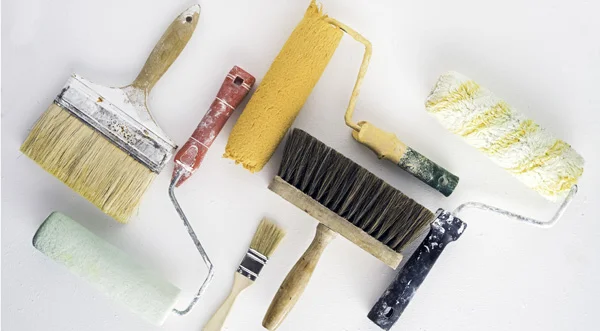How to keep brushes, rollers and other paint tools performance-ready
By Tammy Adamson-McMullen
If you’ve ever ruined a good paint brush or roller because of improper cleanup, you’re not alone. It’s easy to do but also easy to avoid. To keep your tools performance-ready and save money on replacements, always clean up your tools immediately after painting, using the proper procedures and cleaning solutions, and then store the tools appropriately.
Paint Brushes
The key to properly cleaning a paint brush is to tackle the job while the paint is still wet on it. Work patiently; a brush in good shape will take about five minutes to clean. And resist the urge to soak the brush, which could damage its structural integrity.
Before cleaning the brush, try to return as much paint as possible to the paint can by scraping both sides of the brush against the rim. Brush out any remaining paint onto a newspaper.
Next, read the manufacturer’s instructions on the paint can label to determine what cleaning solution you’ll need. In general, latex coatings will require warm water and detergent; oil-based coatings will require a solvent, such as mineral spirits or paint thinner (for paint and varnishes), turpentine (good on caked-on paint) or denatured alcohol (for shellacs).
For latex paint, clean the brush in a sink using detergent and a flowing stream. Release the paint by gently separating the bristles under the stream and bending them together forward and back. As you clean, point the bristles at a downward angle, so that the flow doesn’t damage their ends or soak deep into the ferule. Once the water flows clean, give the brush a final rinse.
For oil-based paint, fill a large glass jar or small bucket with enough solvent to cover the bristles when the brush is standing on end. Dip the brush into the solvent and work the solution through the bristles using either your fingers or a paint brush comb designed for this purpose (available at many paint stores). Shake or spin the brush to release the solvent back into the container. Give the brush a last quick cleaning with detergent and water and then rinse. Note: Wear protective gloves for this step.
To dry the brush, shake or spin it. If you paint frequently, a brush-and-roller spinner is a good investment—and a lot of fun to use! When the brush is dry, store it flat or hang it to maintain the bristles in like-new condition.
Store solvents for future use by straining the expended liquid into a glass jar, using a coffee filter to collect the paint. Let the filter completely dry, then wrap it in newspaper and seal it in a plastic bag for disposal.
Paint Rollers
Rollers can become caked and warped when not cleaned and stored properly. Follow these steps to keep rollers for the long haul.
Remove the roller sleeve from the cage. Position the sleeve above the original paint can and vertically scrape the sleeve top to bottom with a putty knife or 5-in-1 tool to skim any excess paint.
Follow Step No. 2 under “Paint Brushes” to choose the appropriate cleaning solution.
For latex paint, clean the sleeve in the sink using detergent and a flowing stream. As you work, run your hands up and down the sleeve, removing any paint buildup at the ends. Set the sleeve on end and position the faucet so that the flow fills the cavity and creates a waterfall down the sleeve. When the water starts to run clean, turn the roller upside down and repeat the process. Once the roller is clean, give it a rinse.
For oil-based coatings, fill a container with enough solvent to comfortably dip the sleeve up and down into the solution. A 3-gallon bucket is ideal for this purpose. Repeatedly dip the sleeve into the solvent, running your hands up and down the sleeve as you work and removing any excess paint at the ends. Depending on how much paint is on the roller, you may need two buckets of solvent. After one bucket is full of paint, move to the next and continue working until the sleeve is clean. Shake or spin the roller into the bucket to remove excess solvent. Give the brush a last quick cleaning with detergent and water and then rinse. Note: Wear protective gloves for this step.
Clean the roller cage using either the water-and-detergent method for latex paint or container-and-solvent method for oil-based paint. Be sure to clean all of the nooks and crannies in the cage. Rinse the cage and dry it with a towel.
Dry the sleeve by replacing it on the cleaned cage and spinning it outdoors, or use a brush-and-roller spinner. If further drying is needed, put the sleeve on a rope and hang it horizontally; don’t let the roller dry flat or it could warp. Store the dry sleeve in a dust-free cabinet or airtight storage container.
Other Tools
Other paint tools that may need cleaning include trays, 5-in-1 tools, putty knives and so on. Clean these items using either the detergent-and-water method for latex coatings or container-and-solvent method for oil-based coatings. Dry the tools thoroughly before storing so that they don’t rust.
Paint trays in particular can be messy to clean, but don’t neglect doing so! You can make the job easier by emptying as much paint from the tray as possible beforehand. Simply brush any excess into the original paint can and then clean accordingly. Store the clean and dried tray in a dust-free cabinet or airtight container.

